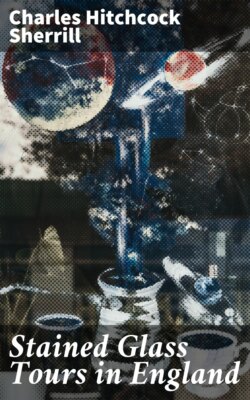Читать книгу Stained Glass Tours in England - Charles Hitchcock Sherrill - Страница 4
На сайте Литреса книга снята с продажи.
LIST OF ILLUSTRATIONS
AND MAPS
ОглавлениеTable of Contents
| To face page | |
| Cambridge, King’s College Chapel | Frontispiece |
| General Map | 19 |
| Map of Early English Tour | 29 |
| Canterbury, “Becket’s Crown” | 38 |
| Thirteenth century medallions; notice circular and other forms enclosing the figures. The heavy iron bars needed to support the great weight of lead are skilfully adjusted to the design. The world-famous shrine stood in the centre of this space. Tomb of Black Prince in foreground, and above it armour he wore at Crécy. | |
| Lincoln, Rose Window | 56 |
| Tracery unusual in that it does not radiate from centre. Quantity of greenish grisaille used emphasises leaf-like design. Thirteenth century medallions in the tall lancets below. | |
| York Minster, “Five Sisters” | 62 |
| Softly toned grisaille, with delicate patterns in faint colour. Of its type unsurpassed in the world. Note difference between mellow strength of this glass and thinness of modern glazing in upper tier of lancets. | |
| Map of Decorated Tour | 75 |
| York Minster, Chapter-House | 78 |
| Note the grouping together in each embrasure of five narrow lights below gracefully elaborated tracery openings. Later on, in the Perpendicular period, these traceries lose their individuality, become stiffly regular, and part of the window below. | |
| Tewkesbury Abbey, Choir | 103 |
| A rare example of rounded apse, generally replaced in England by a square-ended chancel. Chief charm of these windows is their rich colouring. | |
| Wells, “Golden Window” | 119 |
| Notice graceful setting, permitting a glimpse through into the Lady chapel beyond. The large Tree of Jesse, rising from the loins of the patriarch, is portrayed in colours of almost barbaric richness. | |
| Exeter, East Window | 122 |
| Perpendicular stone frame, glazed chiefly with very typically decorated figure-and-canopy glass preserved from the earlier and smaller window. Below and beyond appears the Lady chapel. | |
| Map of Perpendicular Tour | 141 |
| Oxford, New College Antechapel | 145 |
| Transition window, presented by William of Wykeham, Founder of the College. Stone frames are already Perpendicular: note the “pepper-box” tracery lights. The glazing, as usual, lags behind the architecture, and, because of its strong colour and flat drawing, is more Decorated than Perpendicular. | |
| Gloucester, Choir | 162 |
| Great east window commerative of knights who fought at Crécy. Backgrounds of pink and soft blue. Tracery lights no longer differentiated from window below, as during Decorated period. Note elaborate masking of earlier walls by later Perpendicular work. | |
| Coventry, Guildhall | 182 |
| Splendid row of ancient English kings, and, below, a great tapestry. In the centre of the window, and again on the tapestry, appears Henry VI., who was a member of the guild. Handsome example of mediæval hall. | |
| York Minster, East Window | 188 |
| Tremendous sheet of colour, 78 by 32 feet. Lower half of stone frame built in a double plane, and carries a gallery across face of the glass. | |
| Winchester, Nave | 200 |
| The excellent effect produced by the Fifteenth Century fragments with which this window is glazed proves that colour is more important than design in glass. Note swerving to right and left of two principal mullions, thus relieving a monotony of upright lines. | |
| Map of Renaissance Tours | 214 |
| London, St. George’s, Hanover Square | 220 |
| A Renaissance Tree of Jesse from Belgium, readjusted to fit its new embrasures. Figures unusually large for this subject. Fine colours and drawing. | |
| Lichfield, Lady Chapel | 232 |
| Excellent example of Renaissance colouring, freer from applied paint than then customary. This glass was brought from Belgium. | |
| Guildford, Bishop Abbott’s Hospital | 238 |
| Charming and complete glazing of a small chapel. Renaissance glass coloured by the process of enamelling, often unsatisfactory because bits are apt to peel off. |
